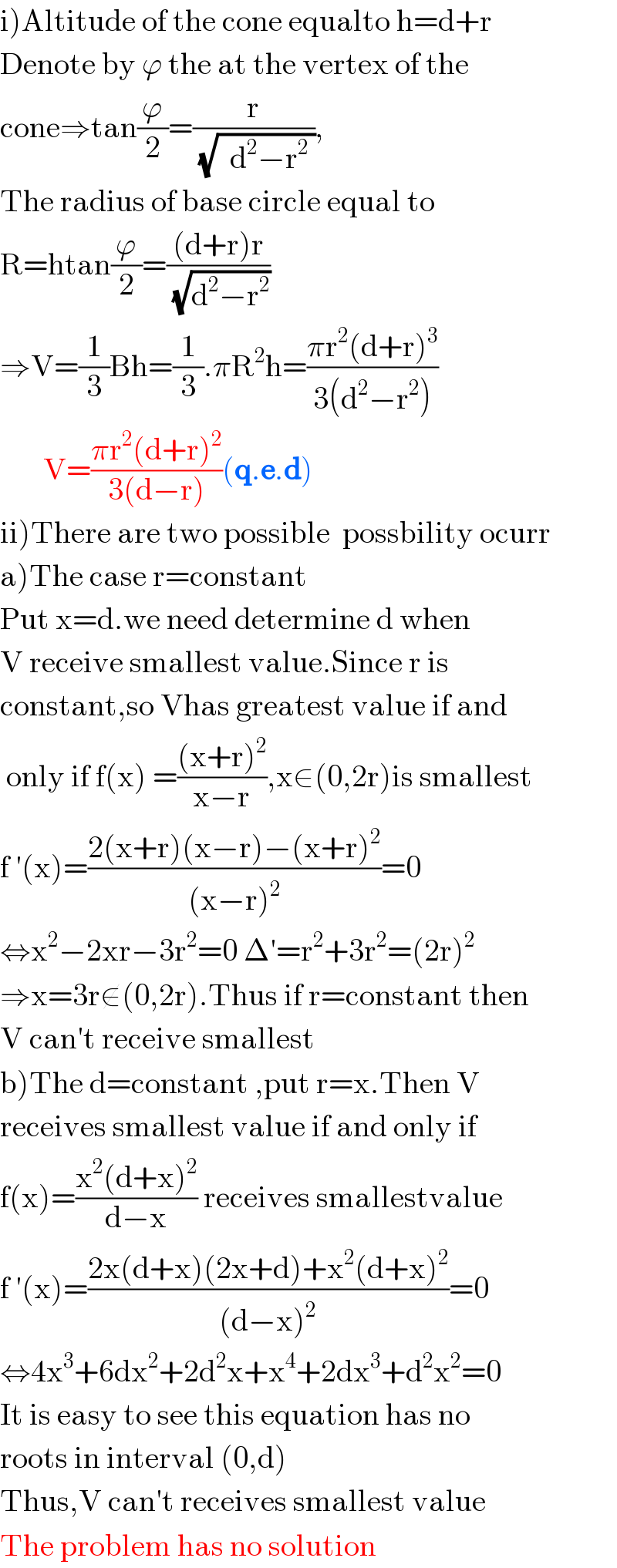Question Number 118069 by Lordose last updated on 15/Oct/20

$$\left.\mathrm{1}\left..\right)\mathrm{i}\right)\:\mathrm{A}\:\mathrm{right}\:\mathrm{circular}\:\mathrm{cone}\:\mathrm{is}\:\mathrm{circumscribed} \\ $$$$\mathrm{about}\:\mathrm{a}\:\mathrm{sphere}\:\mathrm{of}\:\mathrm{radius}\left(\boldsymbol{\mathrm{r}}\right).\:\:\mathrm{If}\:\boldsymbol{\mathrm{d}}\:\mathrm{is}\:\mathrm{the}\: \\ $$$$\mathrm{distance}\:\mathrm{from}\:\mathrm{the}\:\mathrm{center}\:\mathrm{of}\:\mathrm{the}\:\mathrm{sphere} \\ $$$$\mathrm{to}\:\mathrm{the}\:\mathrm{vertex}\:\mathrm{of}\:\mathrm{the}\:\mathrm{cone},\:\mathrm{show}\:\mathrm{that}\:\mathrm{the} \\ $$$$\mathrm{volume}\:\mathrm{of}\:\mathrm{the}\:\mathrm{cone},\boldsymbol{\mathrm{V}}=\frac{\boldsymbol{\pi\mathrm{r}}^{\mathrm{2}} \left(\boldsymbol{\mathrm{r}}+\boldsymbol{\mathrm{d}}\right)^{\mathrm{2}} }{\mathrm{3}\left(\boldsymbol{\mathrm{d}}−\boldsymbol{\mathrm{r}}\right)}. \\ $$$$\left.\mathrm{ii}\right) \\ $$$$\boldsymbol{\mathrm{F}}\mathrm{ind}\:\mathrm{the}\:\mathrm{vertical}\:\mathrm{angle}\:\mathrm{of}\:\mathrm{the}\:\mathrm{cone}\:\mathrm{when} \\ $$$$\mathrm{it}'\mathrm{s}\:\mathrm{volume}\:\mathrm{is}\:\mathrm{minimum}. \\ $$
Answered by 1549442205PVT last updated on 15/Oct/20

$$\left.\mathrm{i}\right)\mathrm{Altitude}\:\mathrm{of}\:\mathrm{the}\:\mathrm{cone}\:\mathrm{equalto}\:\mathrm{h}=\mathrm{d}+\mathrm{r} \\ $$$$\mathrm{Denote}\:\mathrm{by}\:\varphi\:\mathrm{the}\:\mathrm{at}\:\mathrm{the}\:\mathrm{vertex}\:\mathrm{of}\:\mathrm{the} \\ $$$$\mathrm{cone}\Rightarrow\mathrm{tan}\frac{\varphi}{\mathrm{2}}=\frac{\mathrm{r}}{\:\sqrt{\:\:\mathrm{d}^{\mathrm{2}} −\mathrm{r}^{\mathrm{2}} \:}}, \\ $$$$\mathrm{The}\:\mathrm{radius}\:\mathrm{of}\:\mathrm{base}\:\mathrm{circle}\:\mathrm{equal}\:\mathrm{to} \\ $$$$\mathrm{R}=\mathrm{htan}\frac{\varphi}{\mathrm{2}}=\frac{\left(\mathrm{d}+\mathrm{r}\right)\mathrm{r}}{\:\sqrt{\mathrm{d}^{\mathrm{2}} −\mathrm{r}^{\mathrm{2}} }} \\ $$$$\Rightarrow\mathrm{V}=\frac{\mathrm{1}}{\mathrm{3}}\mathrm{Bh}=\frac{\mathrm{1}}{\mathrm{3}}.\pi\mathrm{R}^{\mathrm{2}} \mathrm{h}=\frac{\pi\mathrm{r}^{\mathrm{2}} \left(\mathrm{d}+\mathrm{r}\right)^{\mathrm{3}} }{\mathrm{3}\left(\mathrm{d}^{\mathrm{2}} −\mathrm{r}^{\mathrm{2}} \right)} \\ $$$$\:\:\:\:\:\:\:\mathrm{V}=\frac{\pi\mathrm{r}^{\mathrm{2}} \left(\mathrm{d}+\mathrm{r}\right)^{\mathrm{2}} }{\mathrm{3}\left(\mathrm{d}−\mathrm{r}\right)}\left(\boldsymbol{\mathrm{q}}.\boldsymbol{\mathrm{e}}.\boldsymbol{\mathrm{d}}\right) \\ $$$$\left.\mathrm{ii}\right)\mathrm{There}\:\mathrm{are}\:\mathrm{two}\:\mathrm{possible}\:\:\mathrm{possbility}\:\mathrm{ocurr} \\ $$$$\left.\mathrm{a}\right)\mathrm{The}\:\mathrm{case}\:\mathrm{r}=\mathrm{constant} \\ $$$$\mathrm{Put}\:\mathrm{x}=\mathrm{d}.\mathrm{we}\:\mathrm{need}\:\mathrm{determine}\:\mathrm{d}\:\mathrm{when} \\ $$$$\mathrm{V}\:\mathrm{receive}\:\mathrm{smallest}\:\mathrm{value}.\mathrm{Since}\:\mathrm{r}\:\mathrm{is} \\ $$$$\mathrm{constant},\mathrm{so}\:\mathrm{Vhas}\:\mathrm{greatest}\:\mathrm{value}\:\mathrm{if}\:\mathrm{and} \\ $$$$\:\mathrm{only}\:\mathrm{if}\:\mathrm{f}\left(\mathrm{x}\right)\:=\frac{\left(\mathrm{x}+\mathrm{r}\right)^{\mathrm{2}} }{\mathrm{x}−\mathrm{r}},\mathrm{x}\in\left(\mathrm{0},\mathrm{2r}\right)\mathrm{is}\:\mathrm{smallest} \\ $$$$\mathrm{f}\:'\left(\mathrm{x}\right)=\frac{\mathrm{2}\left(\mathrm{x}+\mathrm{r}\right)\left(\mathrm{x}−\mathrm{r}\right)−\left(\mathrm{x}+\mathrm{r}\right)^{\mathrm{2}} }{\left(\mathrm{x}−\mathrm{r}\right)^{\mathrm{2}} }=\mathrm{0} \\ $$$$\Leftrightarrow\mathrm{x}^{\mathrm{2}} −\mathrm{2xr}−\mathrm{3r}^{\mathrm{2}} =\mathrm{0}\:\Delta'=\mathrm{r}^{\mathrm{2}} +\mathrm{3r}^{\mathrm{2}} =\left(\mathrm{2r}\right)^{\mathrm{2}} \\ $$$$\Rightarrow\mathrm{x}=\mathrm{3r}\notin\left(\mathrm{0},\mathrm{2r}\right).\mathrm{Thus}\:\mathrm{if}\:\mathrm{r}=\mathrm{constant}\:\mathrm{then} \\ $$$$\mathrm{V}\:\mathrm{can}'\mathrm{t}\:\mathrm{receive}\:\mathrm{smallest} \\ $$$$\left.\mathrm{b}\right)\mathrm{The}\:\mathrm{d}=\mathrm{constant}\:,\mathrm{put}\:\mathrm{r}=\mathrm{x}.\mathrm{Then}\:\mathrm{V} \\ $$$$\mathrm{receives}\:\mathrm{smallest}\:\mathrm{value}\:\mathrm{if}\:\mathrm{and}\:\mathrm{only}\:\mathrm{if} \\ $$$$\mathrm{f}\left(\mathrm{x}\right)=\frac{\mathrm{x}^{\mathrm{2}} \left(\mathrm{d}+\mathrm{x}\right)^{\mathrm{2}} }{\mathrm{d}−\mathrm{x}}\:\mathrm{receives}\:\mathrm{smallestvalue} \\ $$$$\mathrm{f}\:'\left(\mathrm{x}\right)=\frac{\mathrm{2x}\left(\mathrm{d}+\mathrm{x}\right)\left(\mathrm{2x}+\mathrm{d}\right)+\mathrm{x}^{\mathrm{2}} \left(\mathrm{d}+\mathrm{x}\right)^{\mathrm{2}} }{\left(\mathrm{d}−\mathrm{x}\right)^{\mathrm{2}} }=\mathrm{0} \\ $$$$\Leftrightarrow\mathrm{4x}^{\mathrm{3}} +\mathrm{6dx}^{\mathrm{2}} +\mathrm{2d}^{\mathrm{2}} \mathrm{x}+\mathrm{x}^{\mathrm{4}} +\mathrm{2dx}^{\mathrm{3}} +\mathrm{d}^{\mathrm{2}} \mathrm{x}^{\mathrm{2}} =\mathrm{0} \\ $$$$\mathrm{It}\:\mathrm{is}\:\mathrm{easy}\:\mathrm{to}\:\mathrm{see}\:\mathrm{this}\:\mathrm{equation}\:\mathrm{has}\:\mathrm{no} \\ $$$$\mathrm{roots}\:\mathrm{in}\:\mathrm{interval}\:\left(\mathrm{0},\mathrm{d}\right) \\ $$$$\mathrm{Thus},\mathrm{V}\:\mathrm{can}'\mathrm{t}\:\mathrm{receives}\:\mathrm{smallest}\:\mathrm{value} \\ $$$$\mathrm{The}\:\mathrm{problem}\:\mathrm{has}\:\mathrm{no}\:\mathrm{solution} \\ $$
